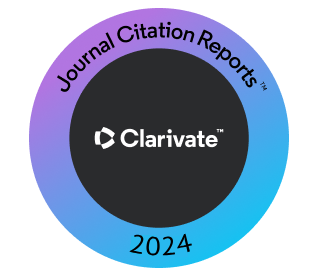The Role of Immune Defense in Serratia marcescens Nosocomial Infections
Abstract
Developing resistance mechanisms leads to various nosocomial infections caused by opportunistic bacteria. Serratia marcescens are well known to be opportunistic and are equipped with an armory of virulence factors against host immune response. The study aims to detect the immune defense in patients infected with multidrug-resistant S. marcescens. The study includes 132 clinical samples, including burn, wound, otitis media, and urinary tract infection (UTI) at several hospitals in Baghdad, Iraq. All isolates are identified by cultivation on MacConkey agar, nutrient agar, and blood agar, followed by biochemical tests and assessment with the VITEK 2 compact system. The isolates are tested for antibiotic susceptibility tests, interleukin-12 (IL12) levels, neutrophil ability to phagocytosis, and complement C3 and C4 levels. Out of 120 positive cultures, six isolates are identified as S. marcescens. The urine samples are the most isolated source and a higher level of antibiotic resistance was noticed in ampicillin and cefotaxime (100%), whereas a lower level is in imipenem. Stimulation (p ꞊ 0.005) provided a significant increase in IL-12 production. The infection with the S. marcescens stimulated the neutrophil’s phagocytosis process compared with the control. The interplay role of virulence factors in S. marcescens influences its pathogenesis, antibiotic resistance, and immune response, particularly involving neutrophils and IL-12. Understanding these interactions is crucial for developing effective therapeutic strategies.
Downloads
References
Abdul, F.R., Abbas, M.K., Rasool, K.H., and Raheem, I.A., 2022. The contribution of interleukin (17) in Iraqi patients with type I diabetes and positive agglutination sera with Morganella morganii antigens. International Journal of Design and Nature and Ecodynamics, 17(5), pp.767-772.
Abdul, F.R., Subhi, H.T., Taher, N.A., and Raheem, I., 2019. Activity of Iron oxide nanoparticles on bacterial biofilm formation. International Journal of Pharmaceutical Sciences and Research, 11(3), pp.1126-1130.
Abhishek, C., and Tanu, J., 2020. Biochemical and Molecular Methods for Bacterial Identification. Springer, Germany, pp.425-468. Ayano, M., and Horiuchi, T., 2023. Complement as a biomarker for systemic lupus erythematosus. Biomolecules, 13(2), pp.367-367.
Bai, H., Mu, L., Qiu, L., Chen, N., Li, J., Zeng, Q., Yin, X., and Ye, J., 2022. Complement C3 regulates inflammatory response and monocyte/macrophage phagocytosis of Streptococcus agalactiae in a teleost fish. International Journal of Molecular Sciences, 23(24), p.15586.
Bhor, R., Rafati, S., and Pai, K., 2021. Cytokine saga in visceral leishmaniasis. Cytokine, 147, p.155322.
Britt, E.C., Lika, J., Giese, M.A., Schoen, T.J., Seim, G.L., Huang, Z., Lee, P.Y., Huttenlocher, A., and Fan, J., 2022. Switching to the cyclic pentose phosphate pathway powers the oxidative burst in activated neutrophils. Nature Metabolism, 4(3), pp.389-403.
Cai, J., Zhang, Y., Jiang, X., Hu, Y., and Chen, W., 2024. Thermally resistant nuclease in Serratia marcescens hinders PCR reactions and degrades PCR products. Cell Biochemistry and Function, 42(4), p.e4032.
Dong, J., Wang, W., Zhou, W., Zhang, S., Li, M., Li, N., Pan, G., Zhang, X., Bai,J., and Zhu, C., 2022. Immunomodulatory biomaterials for implantassociated infections: From conventional to advanced therapeutic strategies. Biomaterials Research, 26(1), p.72.
Drummond, S.E., Maliampuraka A., Jamdar A., Melly L., and Holmes S., 2023. Serratia marcescens causing recurrent superficial skin infections in an immunosuppressed patient. Skin Health and Disease, 3, p.e283.
Ernst, O., Khan, M.M., Oyler, B.L., Yoon, S.H., Sun, J., Lin, F.Y., Manes, N.P., MacKerell, A.D., Jr., Fraser, I.D.C., Ernst, R.K., Goodlett, D.R., and NitaLazar,A., 2021. Species-specific endotoxin stimulus determines toll-like receptor 4-and caspase 11-mediated pathway activation characteristics. mSystems, 6(4), p.e0030621.
Ferreira, R.L., Rezende, G.S., Damas, M.S.F., Oliveira-Silva, M., PitondoSilva, A., Brito, M.C.A., Leonardecz, E., De Góes, F.R., Campanini, E.B., Malavazi, I., Da Cunha, A.F., and Pranchevicius, M.D.S., 2020. Characterization of KPC-producing Serratia marcescens in an intensive care unit of a Brazilian tertiary hospital. Frontiers in Microbiology, 11, p.956.
Friedrich, I., Bodenberger, B., Neubauer, H., Hertel, R., and Daniel, R., 2021. Down in the pond: Isolation and characterization of a new Serratia marcescens strain (LVF3) from the surface water near frog’s lettuce (Groenlandia densa). PLoS One, 16(11), p.e0259673.
Gravrand, V., Ariey, F., Terracol, L., Poupet, H., Doloy, A., Poyart, C., and Mammeri, H., 2022. Frameshift mutation (690delG) in cpxA contributes to the extensive drug resistance of a Serratia marcescens clinical isolate. The Journal of Antimicrobial Chemotherapy, 77(6), pp.1611-1616.
Haidar, A., Muazzam, A., Nadeem, A., Atique, R., Naveed, A., Sharif, J., Perveen,A., Fatima, H. R., and Samad, A., 2024. Biofilm formation and antibiotic resistance in Pseudomonas aeruginosa. The Microbe, 3, p.100078.
Hayashi, W., Yoshida, S., Izumi, K., Koide, S., Soga, E., Takizawa, S., Arakawa, Y., Nagano, Y., and Nagano, N., 2021. Genomic characterisation and epidemiology of nosocomial Serratia marcescens isolates resistant to ceftazidime and their plasmids mediating rare blaTEM-61. Journal of Global Antimicrobial Resistance, 25, pp.124-131.
Hortová-Kohoutková, M., Tidu, F., De Zuani, M., Šrámek, V., Helán, M., and Frič, J., 2020. Phagocytosis-inflammation crosstalk in sepsis: New avenues for therapeutic intervention. Shock, 54(5), pp.606-614.
Hsueh, K., 2020. Fevers and sepsis. In: Spec, A., Escota, G.V., Chrisler, C., and Davies, B., Eds. Comprehensive Review of Infectious Diseases. 1st ed. Elsevier, USA, p.181. Iain, L., Hirschfeld, J., Kantarci, A., Wilensky, A., and Shapira, L., 2023. The role of the host-neutrophil biology. Periodontology 2000, 10.1111/prd.12490, pp.1-47.
Ishii, K., Adachi, T., Hamamoto, H., and Sekimizu, K., 2014. Serratia marcescens suppresses host cellular immunity via the production of an adhesion-inhibitory factor against immunosurveillance cells. The Journal of Biological Chemistry, 289(9), pp.5876-5888.
Jia, X., Zhao, K., Liu, F., Lin, J., Lin, C., and Chen, J., 2022. Transcriptional factor OmpR positively regulates prodigiosin biosynthesis in Serratia marcescens FZSF02 by binding with the promoter of the prodigiosin cluster. Frontiers in Microbiology, 13, p.1041146.
Jiang, H., Zhai, T., Yu, Y., Li, X., Gong, P., Zhang, X., Li, G., and Li, J., 2020. Delayed IL-12 Production by macrophages during Toxoplasma gondii infection is regulated by miR-187. Parasitology Research, 119(3), pp.1023-1033.
Jupatanakul, N., Pengon, J., Selisana, S.M.G., Choksawangkarn, W., Jaito, N., Saeung, A., Bunyong, R., Posayapisit, N., Thammatinna, K., Kalpongnukul, N., Aupalee, K., Pisitkun, T., and Kamchonwongpaisan, S., 2020. Serratia marcescens secretes proteases and chitinases with larvicidal activity against Anopheles dirus. Acta Tropica, 212, p.105686.
Kwok, A.J., Allcock, A., Ferreira, R.C., Cano-Gamez, E., Smee, M., Mentzer, A.J., Todd, J.A., and Knight, J.C., 2023. Neutrophils and emergency granulopoiesis drive immune suppression and an extreme response endotype during sepsis. Nature Immunology, 24(5), pp.767-779.
Maqsood, M., Suntharalingham, S., Khan, M., Ortiz-Sandoval, C.G., Feitz,W.J.C., Palaniyar, N., and Licht, C., 2024. Complement-mediated two-step NETosis: Serum-induced complement activation and calcium influx generate NADPH oxidase-dependent NETs in serum-free conditions. International Journal of Molecular Sciences, 25(17), p.9625.
Copyright (c) 2025 Ihsan A. Raheem, Fatima R. Abdul , Hanan T. Subhi

This work is licensed under a Creative Commons Attribution-NonCommercial-ShareAlike 4.0 International License.
Authors who choose to publish their work with Aro agree to the following terms:
-
Authors retain the copyright to their work and grant the journal the right of first publication. The work is simultaneously licensed under a Creative Commons Attribution License [CC BY-NC-SA 4.0]. This license allows others to share the work with an acknowledgement of the work's authorship and initial publication in this journal.
-
Authors have the freedom to enter into separate agreements for the non-exclusive distribution of the journal's published version of the work. This includes options such as posting it to an institutional repository or publishing it in a book, as long as proper acknowledgement is given to its initial publication in this journal.
-
Authors are encouraged to share and post their work online, including in institutional repositories or on their personal websites, both prior to and during the submission process. This practice can lead to productive exchanges and increase the visibility and citation of the published work.
By agreeing to these terms, authors acknowledge the importance of open access and the benefits it brings to the scholarly community.













 ARO Journal is a scientific, peer-reviewed, periodical, and OAJ that has no APC or ASC.
ARO Journal is a scientific, peer-reviewed, periodical, and OAJ that has no APC or ASC.